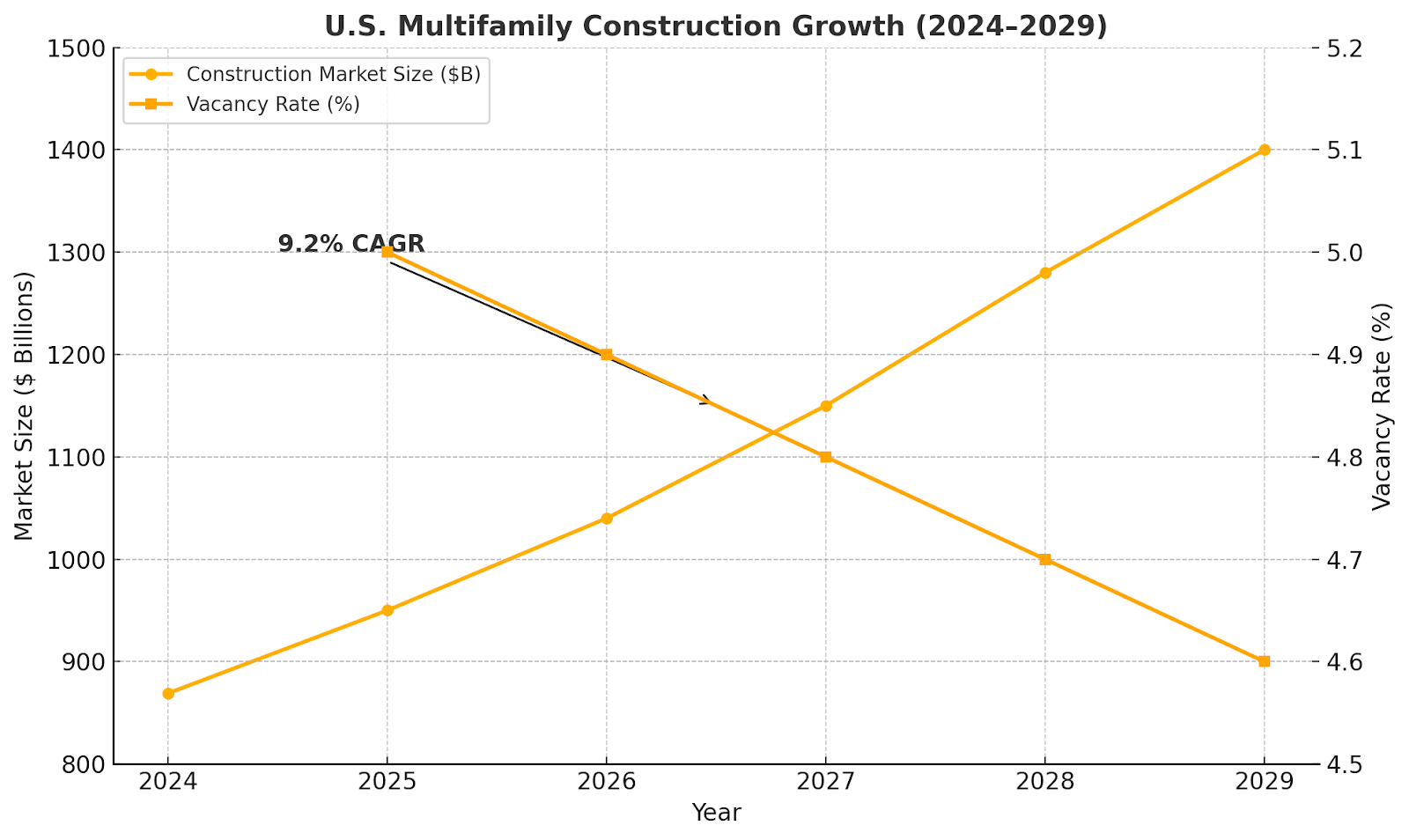The multifamily housing sector stands at a pivotal moment where technological innovation converges with evolving tenant expectations, revealing an exciting frontier: the metaverse. Moving beyond the hype to envision multifamily housing's digital future unveils unique opportunities to transform how investors, operators, and residents interact with both digital and physical living spaces.
The Current Reality of Multifamily Housing
In 2025, the multifamily housing market in the United States continues demonstrating robust growth and resilience. The construction market alone is projected to rise from $869 billion in 2024 to nearly $950 billion in 2025, representing a compound annual growth rate (CAGR) of 9.2%.
By 2029, this figure could exceed $1.4 trillion, driven by shifting demographics, urbanization trends, and an increasing focus on sustainable, technology-integrated living spaces.
Market fundamentals remain strong: vacancy rates have tightened to 5% in Q1 2025, while rents are accelerating at approximately 0.8% year-over-year. This reinforces robust demand across markets, particularly in dynamic regions like the Sun Belt and Midwest.
Tenant preferences are shifting markedly. Sustainability and smart home technology have evolved from nice-to-have features to non-negotiables. Today's renters expect energy-efficient fixtures, LED lighting, smart thermostats, and keyless entry systems as standard amenities. This sustainability focus not only reduces operational costs but attracts eco-conscious renters who prioritize green living.
Additionally, remote work—now four times above pre-pandemic levels—has created urgent demand for flexible, resident-centric amenity offerings. Dedicated workspaces and co-working areas have become essential features that multifamily developers and owners must integrate to remain competitive.

Primary line: Construction market growth from $869B in 2024 to $1.4T in 2029.
Secondary line: Vacancy rate trend starting at 5% in 2025.
Callout: Highlighted 9.2% CAGR.
Unpacking the Metaverse: More Than Just Virtual Real Estate
The metaverse, best understood as a persistent, shared virtual environment where users interact via digital avatars, is rapidly evolving from niche tech curiosity to mainstream platform. While fashion and retail industries have been early adopters, multifamily housing stands on the cusp of transformative possibilities within this digital universe.
Contrary to perceptions that the metaverse merely replicates physical space, its true potential lies in complementing human experience by creating immersive, interactive, and scalable environments:
Virtual Leasing and Tours: Digital twins of multifamily properties enable prospective tenants to explore building layouts, communal spaces, and nearby amenities from anywhere in the world. Imagine virtually "walking" around the neighborhood, checking out restaurants or parks—all without requiring an on-site leasing agent. This reduces friction while increasing convenience throughout the leasing process.
Enhanced Marketing and Community Building: Beyond tours, the metaverse allows communities to host virtual fitness classes, social events in clubhouse settings, or experiential retail partnerships that generate ancillary revenue. Younger renters increasingly expect and appreciate these technologically immersive experiences as integral parts of their lifestyle.
Operational Innovations: The metaverse can integrate digital tools for maintenance and property management, including in-unit virtual assistance or augmented reality overlays that guide repairs or package deliveries. These innovations help address labor shortages while streamlining operations.
Challenges and Considerations
However, the metaverse's sensory limitations present real challenges. Unlike the physical world, virtual environments can only engage sight and sound, omitting tactile, olfactory, and other visceral cues fundamental to human experience. As Mark Shraiberg of Trammell Crow Company notes, the digital experience "takes the humanness out" of spatial interactions, forcing designers and developers to rethink how to effectively humanize virtual spaces.
Moreover, adoption pace will vary significantly. While some real estate tech leaders anticipate mainstream metaverse integration in multifamily housing by late 2024 or early 2025, widespread acceptance will likely require several more years as the technology matures and demonstrates clear value propositions.
Why Investors Should Care
For investors evaluating multifamily opportunities, embracing the metaverse represents more than futuristic innovation—it's becoming a strategic imperative:
Market Differentiation: Properties featuring metaverse-enabled platforms and virtual engagement tools will distinguish themselves in crowded markets, particularly appealing to tech-savvy renters and forward-thinking investors focused on long-term innovation.
Expanded Reach and Operational Efficiency: Virtual tours and leasing processes can attract out-of-state or international renters without costly travel requirements, accelerating lease-ups while reducing vacancy periods.
Enhanced Data and Resident Engagement: Digital platforms generate rich datasets on resident preferences and behaviors, enabling tailored marketing, services, and amenity offerings that boost retention and satisfaction rates.
Sustainability and Technology Synergies: The metaverse's digital infrastructure naturally supports broader smart building ecosystems, integrating resident technologies, energy management, and community engagement within unified interfaces.
The Road Ahead: Visioning Multifamily Housing in the Metaverse
Moving beyond the hype, the vision of multifamily housing in the metaverse centers on holistically blending physical and virtual realities. Properties will evolve beyond digital replicas into enhanced ecosystems offering flexible, immersive living and working experiences.
Investors and operators who proactively explore strategic partnerships, pilot digital twin implementations, and integrate metaverse tools will position themselves to thrive within the evolving rental landscape—one increasingly shaped by remote work adoption, sustainability demands, and digital-first lifestyles.
Ready to explore these cutting-edge strategies and invest in multifamily properties that are future-ready in both physical and virtual realms? I invite you to book a call with me, Michael Pouliot, CIO at Carbon.

.svg)



